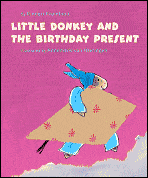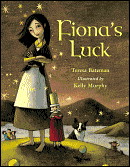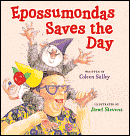Picture Book Round-Up (including a donkey, some ducklings, a diapered possum, and some leprechauns)
 April 25th, 2007 by jules
April 25th, 2007 by jules
Here are some brand-spankin’-new picture book titles as well as a couple from last year that I’m just getting to . . . If anyone is wondering, by the way, yes, we’ll have a blogger interview this week. Look for it on Thursday.
Onwards, then, to some winning picture book titles . . .

by Rindert Kromhout and
illustrated by Annemarie van Haeringen
(translated by Marianne Martens)
First published in 2001 in the Netherlands under the title Kleine Ezel en jarige Jakkie
North-South Books
March 2007
(review copy)
Here’s a lively addition to the list of international books to look for this year, this time a Dutch import. Little Donkey’s back (having been introduced to us in 2006’s Little Donkey and the Baby-Sitter, which I’ve never actually read but really want to now) . . . His friend, Jackie, is having a birthday party, so off Little Donkey and Mama Donkey go to purchase a gift for him. But Little Donkey’s great turmoil is that he wants to keep the present he’s picked out for Jackie: a kite with a long, long tail. He decides it’ll just stay in his possession, offering up alternate toys for Jackie’s gift, but Mama Donkey kindly — but resolutely — says no. He pretends to lose it (buries it in under his bed covers), pretends to have an aching tummy (“‘Mama . . . I don’t want to go to Jackie’s party . . . My tummy hurts,” to which she wisely replies, “Of course you won’t be able to have any cake if your tummy hurts”) and tries to convince Mama that Jackie would want a big bunch of flowers instead — all in an effort to keep the coveted kite. They finally make it to the party (“‘Maybe he won’t like it,’ said Little Donkey. ‘And then he’ll give it back to me.’ ‘Maybe,’ said Mama Donkey with a smile”); Jackie loves the gift, and he and Little Donkey enjoy it all afternoon. At the end of the day, as Mama is telling Little Donkey what a good present he chose for his friend, Little Donkey asks when his birthday is, and the observant child reader will spot a wrapped-up kite hidden in the corner . . . This book is a delight. There’s much to love about it, but here are the two salient pleasures it has to offer: 1) It addresses a highly emotional topic in the lives of children but without too much schloopy-sloshy, syrupy-sweet goings-on and in such a way that the child reader can easily sympathize with Little Donkey’s dilemma. And 2) the distinctive illustrations on display by Annemarie van Haeringen. They are free from banality and are gratifyingly — I hate to say it due to its overuse — quirky. Simply put, they’re fresh, original, crisp. Using simple black lines and bold, vibrant color (particularly the dabs of red on the flower-picking spread), she brings the loving world of Little Donkey to life in her own singular style.

by Jonathan Emmett and illustrated by Rebecca Harry
Scholastic
First American edition: February 2007
Originally published by Macmillan Children’s Books
in the U.K. in 2006
(library copy)
Ruby’s also back (though, like with Little Donkey, I’ve yet to read the previous Ruby books — 2004’s Ruby in Her Own Time; 2004’s Once Upon a Time, Upon a Nest; and this year’s board book, Ruby Flew, Too). Ruby can join the ranks of Ferdinand and even Tad Hills’ Goose (reviewed here by Yours Truly) in that she’d rather not rush around, thanks very much. She has earthly beauties around her to notice, so, please, just let her take her time. Yes, Ruby’s “small and steady and took things slowly, in her own time,” though her siblings — Rufus, Rory, Rosie, and Rebecca — are “always rushing off in search of an adventure.” Ruby’s Zen-like, live-in-the-moment nature saves all the other ducklings’ tails in the end when they get lost on an adventure Ruby simply can’t pass up. While they zoom around from one place to the next, Ruby stops to take in a small waterfall sparkling in the sun; golden fish glimmering in the water; the water lilies; “four fat frogs that lay lazing on the leaves”; and the dragonflies and the willow tree near the water. And her keen observation skills spot the big black storm cloud that her siblings fail to notice. Ruby guides them back home to safety in the end, using all of Mother Nature’s wonders as landmarks to bring everyone home to mother and father duck at their nest by the lake . . . Emmett writes with a fluid rhythm and pleasing alliteration that make this a great read-aloud (“Rufus, Rory, Rosie, and Rebecca rushed off down a winding waterway”). And Rebecca Harry’s bleed-to-the-very-edges illustrations manage to be both peaceful and dynamic at the same time, as she creates such endearing ducklings (while also succeeding in keeping them from being too cloying) and depicting movement with swift, bold brushstrokes. And, as Emmett explains at his site, she does wonders with a darker palette with the thunderstorm spread, seen here.

Text by Traci N. Todd
Chronicle Books
February 2007
(review copy)
This is an alphabet book that your wee train afficionados will enjoy, but I don’t know that it has tremendous appeal above and beyond that particular audience. With text by Traci N. Todd (who brought us A is for Astronaut: Exploring Space from A to Z in 2006) and design by Sara Gillingham, what we have here is a hodgepodge of contemporary but retro-style art and vintage black-and-white photos and images of trains, trains, everything trains for each letter of the alphabet (most letters accompanied by two images). While some entries are a stretch (“N” is for “newspaper: that some people read while riding the train”), many are interesting and will please those who get excited by this particular form of locomotion (“M” is for “M-10000: a fancy, lightweight Union Pacific Railroad Train that first appeared in the 1930s” — and this accompanied by a photo from the Union Pacific Museum). Most of the newly-created illustrations seem to have been created by one Steve Vance; they’re as retro as you can possibly get. Fortunately, there are Image Credits at the book’s close (though each credit is led off with a page number, despite the fact that there exists no page enumeration in the book — just a tad frustrating when you’re wanting to match the corresponding photos with the image credits list, though they’re at least in the order they appear in the book). Artwork from the Union Pacific Museum and many photos from the Canadian Pacific Railway Company fill the book. It probably goes without saying that this title will appeal to adult train lovers as well, particularly due to the book’s fervent resurrection of the photos and images and style of a time period long gone.

by Teresa Bateman and illustrated by Kelly Murphy
Charlesbridge Publishing
January 2007
(library copy)
Ah, the luck of the Irish! “Once, luck was as free to be had in Ireland as sunlight, and just as plentiful,” thanks to the leprechauns, who “made luck like cows made milk.” But when the “big folk” arrive in Ireland, they pretty much suck all the luck towards them. So, under the leprechaun king’s orders, the tiny folk gather all the luck and hide it away. A great famine falls upon Ireland. But fear not; here comes Fiona, a young woman of clever wit. She just knows the leprechauns have to be behind the disappearance of the land’s luck. Fiona knows that getting luck from a leprechaun “would be like squeezing water from a stone . . . Sometimes cleverness, though, is worth more than strength.” And just exactly how plucky Fiona, who’d “rather depend on my wits,” gets the leprechaun king to release the luck is for you to find out when you read this entertaining original folk tale from school librarian Teresa Bateman, who tells her tales well. Kelly Murphy, having created her illustrations in acrylic, watercolor, and gel medium, brings freckle-faced Fiona to life with much spunk and spirit, having fun with perspective when giant Fiona enters the tiny folk’s world to face the leprechaun king at his throne. And Murphy conjures up a whole world with rich, textured colors and in her inimitable style, in this case bringing a real folk-art feel to the story. There are many full-page spreads, each one captivating and always drawing focus, when she’s present, to quick-witted, scheming, winking Fiona. So, if you’ve ever wondered why “you’ll always find some luck roaming free around Ireland,” well . . . you have Fiona to thank. Pick this one up to find out why.

by Coleen Salley and illustrated by Janet Stevens
Harcourt Children’s Books
November 2006
(library copy)
Here’s a title from the end of last year that I’m really slow in getting to . . . But I think it’s worth mentioning. Coleen Salley’s Epossumondas books (2002’s Epossumondas and 2004’s Why Epossumondas Has No Hair on His Tail) — starring a baby possum in a diaper, no less — are fabulous read-alouds, especially when you can get your good Southern twang goin’ . . . In this title (a variation on the Southern folktale “Sody Sallyraytus”), “{o}nce upon a time, but maybe not so long ago,” Epossumondas and his mama are residing in a “little cottage back by the sugarcane fields in Laurel Valley on Bayou Lafourche.” It’s Epossumondas’ birthday, and Mama’s making strawberry shortcake with sweet biscuits for the big day. Unfortunately, her box of sody sallyraytus is empty (that’s an old Southern term for “baking soda,” for you poor, sody-less Northerners). “And you know you can’t make big, light, fluffy biscuits without sody sallyraytus.” Baby Gator and Auntie, who have arrived for the party, and Mama herself are swallowed up with the sody in one big gulp by the “GREAT, HUGE, UGLY LOUISIANA SNAPPING TURTLE” as they head back home after a trip to the store to replenish the sody (all the while singing the repeated refrain of “Sody! Sody! Sody sallyraytus!”). Of course, Epossumondas then heads out and manages to outwit the snapping turtle, thus saving Mama, Auntie, and Baby Gator in the end. All the colorful Southern expressions are here (a “Well, I swaney!” here and a “soppin’ mad” there and then a “sugar pie” and “land sakes!” for good measure). These Epossumondas books are brimming with pure silliness and fun and rambunctious energy and lots of appeal for children, making them sure-fire story-time hits, too. Stevens’ colorful illustrations (mixed media on watercolor paper) are full of humor and detail, and — while the book’s antagonist is appropriately and satisfyingly frightening — her heavy use of rounded lines softens the edge a bit on the GREAT, HUGE, UGLY LOUISIANA SNAPPING TURTLE (particularly effective towards this goal is the amusing illustration on the book’s back of the bruised, ego-shrunken turtle with Band-aids all over his face). Salley includes an author’s note, which explains the meaning of “sody sallyraytus” and provides a bit of background on Laurel Valley. Here’s to “the bravest possum ever . . .”

A Lift-the-Flap Book of Hidden Potential
by Durga Bernhard
Chronicle Books
April 2006
(review copy)
This book is even older than the previous one, dating back to this time last year, but it’s too good to not mention. Gather your favorite wee-est one to your side to read this lift-the-flap book “of hidden potential.” Durga Bernhard brings us — in beautifully-rendered gouache watercolors that have a real texture to them — the beauties, the gifts, the life, the imagination, and the potential of what lurks inside everything from an acorn (“In the acorn . . . is a tree waiting to grow tall”) to “you,” the reader (“In you . . . is a story waiting to be told”). Where you see those ellipses is where you, as the reader, would lift the flap to discover what’s lying inside. Some flaps lift up (“In the cloud . . . is a storm waiting to bring rain,” which opens up to a dark sky with dramatic lightning strikes), while most lift to the right (“In the blossom . . . is a plum waiting for the sun,” which opens out to a blooming pear tree) and two open down (including, “In the thread is a weaving waiting to be spun,” opening down to a mother’s arms tenderly wrapping a newborn with a woven blanket). It’s a lovely, life-affirming concept for a picture book, which can serve as a launching point for elementary students to search for the creative possibilities lying hidden in other aspects of their lives. A great read-aloud choice for an elementary story-time, this is a true celebration of the very spirit of growth and life.
